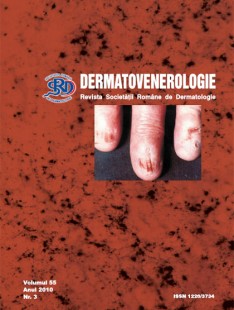Clinical cases
Frontal fibrosis alopecia: observations on two cases
Introduction:
Frontal fibrosing alopecia is a primary cicatricial alopecia affecting mainly postmenopausal women and characterized by a bandlike area of symmetric hair loss involving the frontal and parietal areas and less frequently associated with alopecia of the eyebrows, axillae and groin. This association approaches it to Piccardi-Lasseur-Graham-Little syndrome which is characterized by the triad of multifocal cicatricial alopecia of the scalp, nonscarring alopecia of the axillae and/or groin, and keratotic follicular papules.
Clinical case 1:
A 56-year-old postmenopausal woman has been presenting a symmetrically hair loss in frontoparietal area with progressive extension in preauricular region for 3 years, associated with loss of follicular orifices, skin atrophy and perifollicular erythema at the scalp margin. Histopathological examination showed decrease in the number of hair follicles, perifollicular lamellar fibrosis, chronic lymphocytic infiltrate surrounding the infundibular and the isthmus portions of the hair follicles. Laboratory examinations including routine biochemistry, thyroid function and antinuclear antibodies were negative. The treatment consisted in topical and systemic corticosteroids.
Clinical case 2:
A 37-year-old female patient has been noticed a bandlike area of symmetrically hair loss in her frontoparietal area associated with perifollicular erythema for 2 years and partial alopecia of the eyebrows with subjacent erythema for 1 year. Histopathological examination showed perifollicular lamellar and canalicular fibrosis and rare perifollicular lymphocytic infiltrates. Seric level of androgens was normal. Treatment consisted in intralesional steroids.
Conclusion:
Frontal fibrosing alopecia is a cicatricial alopecia doe to destruction of hair follicles by an inflammatory lymphocytic infiltrate that is localized around the upper portion of the hair follicles with selective involvement of certain androgen-dependent areas and it is considered a form of lichen planopilaris.


